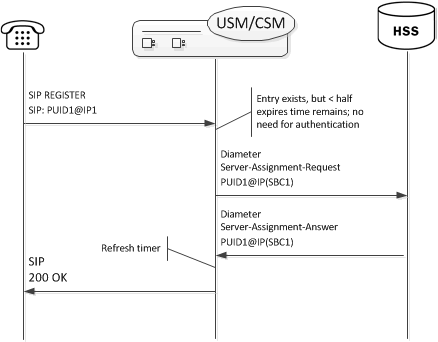Register Refresh
When a UA sends a register refresh, the Oracle Communications Unified Session Manager first confirms that the authentication exists for that UE’s registration cache entry, and then is valid for the REGISTER refresh. (If a valid hash does not exist for that AoR, then the Oracle Communications Unified Session Manager sends an MAR to the HSS to retrieve authentication data once again).
Next, the Oracle Communications Unified Session Manager determines if the it can perform a local REGSITER refresh or if the HSS needs to be updated. If any of the following 3 conditions exists for the re-registering UA, the Oracle Communications Unified Session Manager updates the HSS:
- The location update interval timer has expired—This value, configured in the sip registrar configuration element ensures that HSS database always has the correct Oracle Communications Unified Session Manager address by periodically sending SARs for each registered contact.
- The message’s call-id changes while the forward-reg-callid-change option in the sip config configuration element is set. This covers the case where the UA changes the Oracle Communications Unified Session Managers through which it attaches to the network.
- The REGISTER message’s Cseq has skipped a number. This covers the case in which a user registered with Oracle Communications Unified Session Manager1, moves to Oracle Communications Unified Session Manager2 , and then returns to Oracle Communications Unified Session Manager1.
If the Oracle Communications Unified Session Manager updates the HSS database because of matching one of the above conditions, the access side expiration timer per contact is reset to the REGISTER message’s Expires: header value, and returned in the 200 OK. This happens even in the case when the reREGISTER was received in the first half of the previous Expires period. In addition, the core-side location update interval timer are refreshed on both active and standby.
When the above three conditions are not met, the registration expiration proceeds normally.
If the timer has not exceeded half of its lifetime, a 200 OK is returned to the UA. If the timer has exceeded half of its lifetime, the Oracle Communications Unified Session Manager just refreshes the access-side expiration timer; the registration cache expiration timer for that AoR begins its count again.
